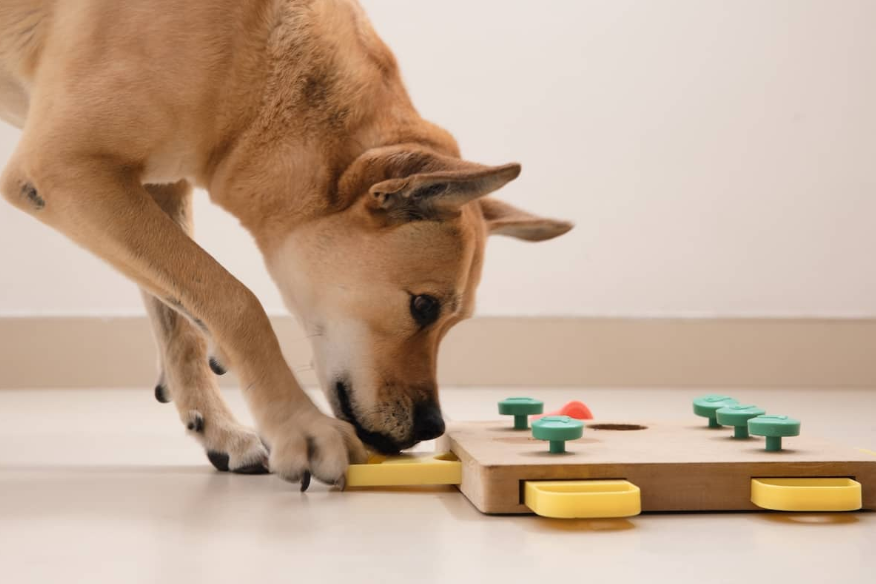For dog owners, witnessing the sheer joy and enthusiasm their furry companions exhibit while playing with toys is a familiar delight. However, beyond mere entertainment, certain toys offer more profound benefits, impacting a dog’s brain health and behavior positively.

In this article, we delve into the world of dog puzzle toys, specially crafted to stimulate a dog’s intellect and problem-solving skills. We discuss the advantages they offer, provide insights into selecting the right puzzle toy tailored to your dog’s personality and capabilities, and offer guidance on seamlessly integrating them into your pet’s daily routine.
Discover why dog puzzle toys serve as invaluable tools in fostering your dog’s happiness, well-being, and mental acuity.
The Multifaceted Benefits of Dog Puzzle Toys
Dogs, renowned for their intelligence and zest for life, thrive on mental stimulation and physical engagement. While conventional toys like balls and chew items provide amusement, puzzle toys elevate playtime to a new level by challenging a dog’s inherent problem-solving abilities.
These interactive puzzles captivate a dog’s curiosity and cognitive faculties, making play sessions not only enjoyable but also mentally enriching. Consequently, they serve as indispensable aids in promoting cognitive development, alleviating boredom, and curbing undesirable behavioral patterns.
How Dog Puzzle Toys Cultivate Mental Agility and Enhance Cognitive Function
Central to the design of dog puzzle toys is their ability to engage a dog’s cognitive faculties. These toys necessitate strategic thinking and manipulation to access hidden compartments or retrieve treats, providing a stimulating mental workout.
As dogs grapple with the puzzle’s complexities, they engage in a process that enhances problem-solving skills, spatial awareness, and memory retention. This cognitive exercise fortifies neural pathways, fostering cognitive resilience and bolstering overall mental acuity.
Moreover, puzzle toys serve as potent tools in mitigating age-related cognitive decline in senior dogs. By sustaining mental stimulation and engagement, these toys help preserve cognitive sharpness and stave off the effects of aging.
Mitigating Boredom and Preventing Behavioral Issues
Dogs, inherently curious and energetic beings, are susceptible to boredom when their mental and physical needs remain unfulfilled. Left unaddressed, boredom can manifest in undesirable behaviors such as excessive barking, chewing, or destructive tendencies.
Puzzle toys serve as effective antidotes to boredom, offering a compelling outlet for a dog’s energy and mental engagement. By presenting challenges that demand concentration and problem-solving prowess, these toys captivate a dog’s attention, mitigating the risk of boredom-induced behavioral issues.
Moreover, puzzle toys prove invaluable for dogs left alone for extended periods. By providing mental stimulation and diversion, they assuage separation anxiety and forestall destructive behaviors stemming from loneliness and monotony.
Selecting the Ideal Dog Puzzle Toy for Your Canine Companion
Choosing a puzzle toy tailored to your dog’s temperament and proficiency level is paramount to ensuring a rewarding and enriching experience. Consider the following factors when selecting a puzzle toy:
Difficulty Level: Match the complexity of the toy to your dog’s current skill level, gradually increasing the challenge as they become more adept.
Breed and Size: Factor in your dog’s breed characteristics and physical abilities when selecting a toy, opting for designs suited to their size and preferences.
Food Motivation: Assess your dog’s affinity for food rewards and select toys that align with their preferences, whether treat-dispensing or alternative reward mechanisms.
Interactive vs. Solitary Play: Choose between toys that foster interactive play with you or solitary engagement, depending on your dog’s social inclinations and your availability for play sessions.
Incorporating Dog Puzzle Toys into Your Dog’s Daily Routine
Integrating puzzle toys into your dog’s daily regimen offers myriad benefits for their physical, mental, and emotional well-being. Follow these tips to seamlessly incorporate puzzle toys into your pet’s routine:
Introduce Gradually: Familiarize your dog with puzzle toys gradually, introducing one toy at a time to prevent overwhelm and ensure a positive experience.
Establish Routine: Dedicate specific playtime slots for puzzle toys, integrating them into your dog’s daily exercise regimen or as standalone activities to reinforce mental stimulation and enjoyment.
Rotate Toys: Maintain novelty and sustained interest by rotating puzzle toys regularly, offering fresh challenges and preventing boredom.
Use as Rewards: Employ puzzle toys as rewards for good behavior or as engaging diversions during periods of downtime or when your dog is home alone.
Supervise and Encourage: Initially supervise your dog’s interaction with puzzle toys, offering encouragement and positive reinforcement to build confidence and motivation.
By integrating dog puzzle toys into your pet’s routine, you provide them with not only a source of enjoyment but also a catalyst for cognitive development, emotional fulfillment, and behavioral harmony.
In Conclusion
Dog puzzle toys transcend mere entertainment, offering profound benefits for your pet’s cognitive health and behavior. By selecting the right puzzle toy tailored to your dog’s needs and incorporating it into their daily routine, you provide them with a stimulating and enriching experience.
Embrace the opportunity to enhance your dog’s well-being and deepen your bond through the engaging world of puzzle toys. Witness firsthand the transformative impact these toys can have on your furry friend’s happiness and vitality.
